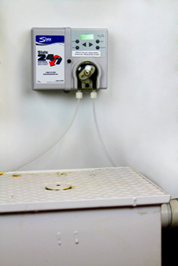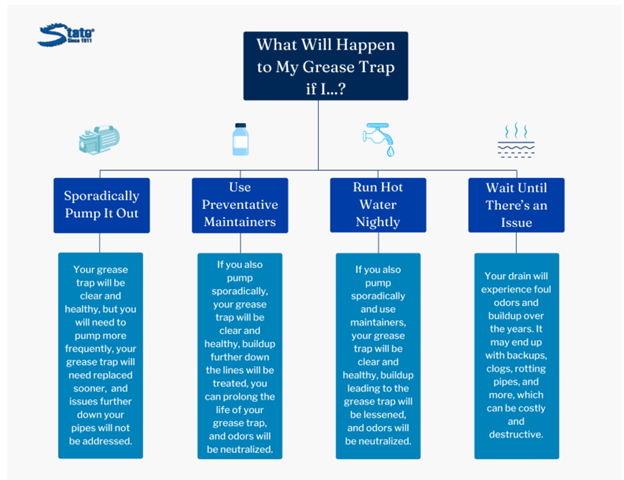How Should I Treat Odors in My Grease Trap?
How Should I Treat Odors in My Grease Trap?
Foul odors wafting up from your grease trap don’t exactly exclaim, “Eat at my restaurant!” They don’t necessarily say, “Go to my school,” “Visit my hotel,” or “Work at my facility” either. So, you want to treat these odors—both for your own sanity and for the sake of your customers. But you have other priorities, other issues, other day-to-day functions to deal with. You don’t have the time for a drawn-out ordeal; where do you even begin?
State Chemical has been selling and servicing grease trap maintainers for decades, including Line Bac’R, Grease-B-Gone, Ecolution Drain Line Maintainer, D-Stroy, and PrimeZyme. We understand that your mindset toward your grease trap might be “out of sight, out of mind” until an issue pops up, and it’s hard to figure out what you need when you’re suddenly scrambling for solutions.
We’ve written this article to explain everything you need to know about treating your grease trap odors. After reading, you’ll be ready to make a well-informed decision about what your grease trap needs in order to get back into prime condition.
In this article, we’ll cover the following:
- Why does my grease trap smell?
- How do I treat grease trap odors?
- What happens if I don’t treat my grease trap?
- What should a healthy grease trap look like?
Why Does My Grease Trap Smell?
The job of a grease trap is to collect items going down your sink that you don’t want in your drain lines. For example, if you’re running a fast-food restaurant, you probably can’t stop food particles and grease from going down your drains to some extent. That’s where the grease trap comes in, limiting the amount of fats, oils, and greases (FOGs) and other items that go down your drain so that your water can keep flowing.
If your grease trap smells, it’s because of the items it’s collecting. Especially if you’re in the food industry, these items are likely FOGs. When items like grease or dairy sit in your grease trap, they will start to rot after a while, and especially as more food coalesces, this issue will only get worse.
Similarly, if you’re in, say, an art facility, you could be dealing with odors in another form. Clay, wood shavings, paint, or other items will also begin to smell as they sit and take on water in your grease trap.
Essentially everything that goes down your drain contributes to buildup, and organics create odors. So, what can you do about this? Pumping and chemical maintenance are the answer.
How Do I Treat Grease Trap Odors
Grease traps must be maintained in order to function correctly. If you don’t maintain them, you won’t only be risking bad smells but also backups, clogs, and even rotting pipes. So, how do you maintain grease traps to control odors?
Pump Your Grease Trap
Pumping your grease trap is necessary regardless of any chemical maintenance you may practice. After a while of normal sink usage, organics will build up in your grease trap, and it’ll be too much to wash down your sink. This will lead to foul odors and, eventually, clogs. When your grease trap gets to be about a quarter of the way full, it’s time to pump.
Practice Preventative Maintenance
The most effective way to eliminate odors and prevent future backups is to practice preventative maintenance. Pumping your grease trap is a necessity to physically remove buildup, but you can better control odors, delay the need to pump, and prolong your grease trap’s life by also using preventative maintenance.
Grease trap maintainers are usually set up on a feed pump that dispenses the chemicals as frequently as 24/7. The chemicals then break down buildup in the grease trap and continue to do so all the way through your pipes from that point on.
If you use a bacterial maintainer, the bacteria colony digests FOGs into water and air, lessening buildup. Meanwhile, if you use another maintainer, such as an emulsifier, the buildup will be liquified so that it easily passes through the pipes.
When choosing a grease trap maintainer, just be careful about what kind you choose based on your drain. For standard situations, any type of maintainer should be effective, so your choice will usually be based on price and the size of your facility. However, it’s important to note that bacterial grease trap maintainers should not be used in environments that utilize sanitizers or disinfectants.
Sanitizers and disinfectants kill bacteria, rendering your bacterial maintainers useless. For this reason, you cannot, for example, use bacterial grease trap maintainers in the grease traps of three-compartment sinks. These sinks use disinfectant or sanitizer in the third compartment, so bacterial maintainers simply won’t work here. Similarly, don’t dump disinfectant from your mop buckets down a drain leading to a grease trap that uses a bacterial maintainer. This will put you in the same situation. Instead, use another product, such as an emulsifier, in these environments.
By taking preventative steps now, you can eliminate your grease trap odors and lessen buildup before the issue expands into something worse. Be careful about the type of maintainer you choose, and you’ll be set for success.
Run Hot Water Down Your Sink Every Night
To eliminate odors even more effectively, we recommend running hot water down your sink each night. Preventative maintainers are great at breaking down buildup—but they only break it down starting from where they enter the drain line. Normally, this is not at the sink’s opening, so foods can still congeal in the pipes before they reach the maintainer.
If you run hot water down your sink, you’re loosening the buildup to prevent odors and issues further up the line, which is just as important as treating your grease trap.
What Happens If I Don’t Treat My Grease Trap Odors?
The thing is, if you have grease trap odors, it’s indicative of buildup. If you don’t treat the odors, you’re also not treating the buildup.
Preventative maintenance is the best way to do this. It will get rid of bad odors that may deter customers, but it will also remove the buildup in your grease trap and help the grease trap last longer. You may be thinking, “Why should I use chemical maintainers if I already regularly pump my grease trap?” The answer is that pumping only cleans out the grease trap. All the buildup that gets through the grease trap, however, is now sitting in your drains.
Here is an example from a customer we worked with: This business pumped out their grease trap regularly but hadn’t used preventative maintainers in years. They were starting to notice slow-flowing water, so they wanted to start preventative maintenance. During the process of setting this up, it was discovered that the business had one long pipe running under their floor that was backed up with years of buildup that had gotten through the grease trap. It had gotten so bad that the line started to rot, and hardly anything was coming out the other end of the pipe. If this rot had continued, the floor would’ve eventually caved in.
The only issue the business noticed before seeking preventative maintenance was slow-flowing water. This just goes to show how massive issues can develop right under your nose. Imagine if this kind of rot developed in a pipe running under a parking lot. You’d have to hammer into the line to determine what was going on and treat it, which would mean tearing up the parking lot. Preventative maintenance helps your business avoid the costly and destructive outcome of years of buildup. Learn more about the cost difference between pumping and grease trap maintenance.
What Should a Healthy Grease Trap Look Like?
So, unhealthy grease traps are odorous and full of buildup. But what does a healthy grease trap look like?
A healthy grease trap should be full of mostly liquid, and when looking at it, you shouldn’t be able to notice any solids. The water will often be colored, but if it’s an intense color, such as a bright orange, that’s abnormal. Similarly, if the water appears thick, that’s a sign that something is wrong.
Your Next Step: Pump Your Grease Trap Regularly and Invest in Preventative Maintenance
You wanted to figure out how to treat odors in your grease trap, and now you know that it’s just as much about treating odors as it is about preventing damaging buildup. Your next step is to learn about the price of grease trap chemicals from State Chemical so that you can find the right product for your facility and your wallet.











